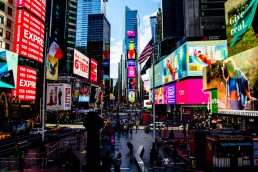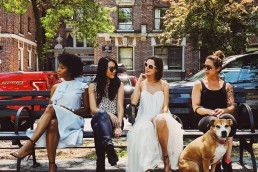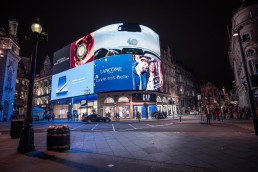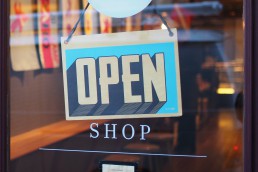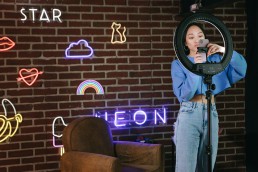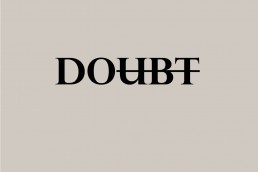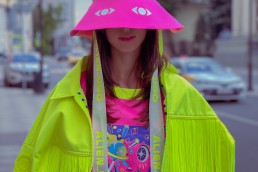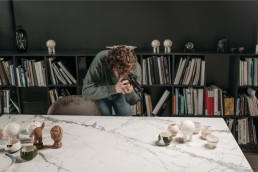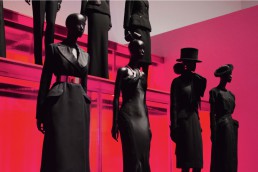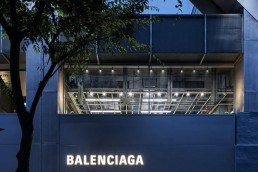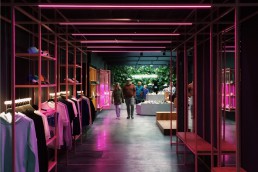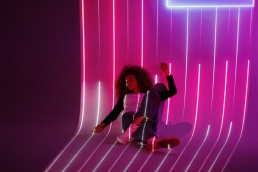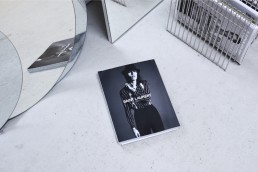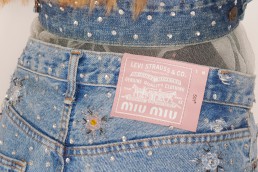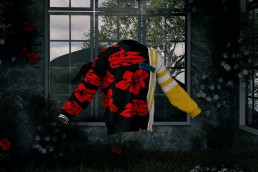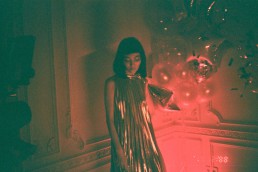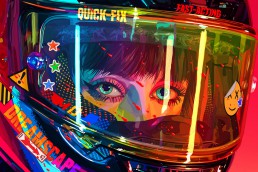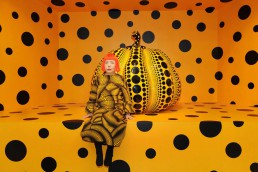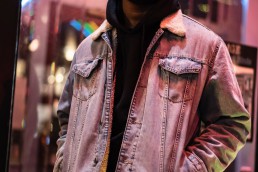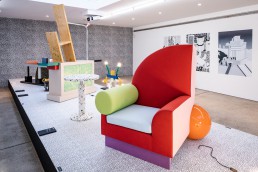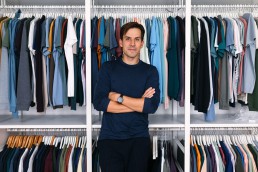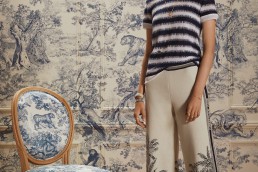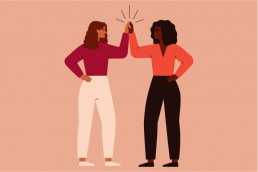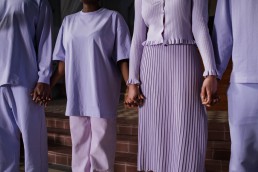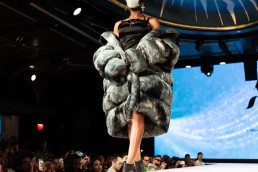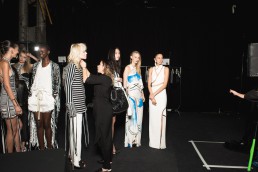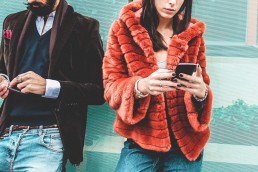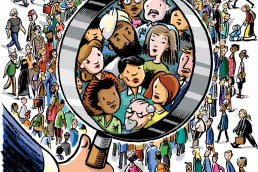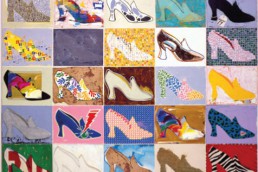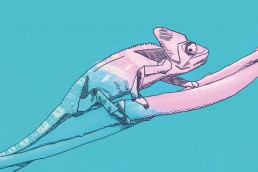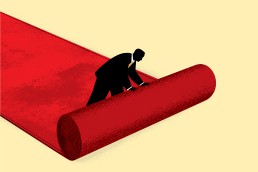Why Having a Flagship Store Can Help Your Brand Positioning and Reputation
The flagship store has evolved from a high-exclusive place into a dynamic shopping retail experience right at the customer’s disposal. A flagship store is a communication statement, an experiential invitation that blends sensations and commerce.
The store for the fashion industry is like the studio for a fashion designer, irreplaceable. The international retail landscape has changed for several brands in all fashion segments. Despite the e-commerce success, the store is the ultimate place where brand and customer converge; a commercial arena where product, perceptions, emotions, and customer satisfaction are being played.
The flagship store can enhance the brand image and provide valuable communication impact. An effective flagship store attracts new customers and keeps the current loyal ones hooked to the brand. The aim of a flagship store is to stimulate the emotional sensations and physical attributes that the brand possesses and showcase them to the customer.
According to Kozinetz et al., three main characteristics can define a flagship store:
- They carry only a single brand of product (although this may not be completely accurate as different brand lines can coexist in a flagship).
- They are company-owned.
- They operate intending to build brand image rather than solely to generate profit for the company.
Luxury companies usually establish flagship stores as an instrument to present a consistent brand identity regardless of the country or the cultural context.
Flagship stores have a strategic purpose, and some of their characteristics surpass the three previous assumptions.
To be present in an international location does not translate exactly on having “a flagship” store, to be considered one, it has to meet some requirements, such as dimension, they usually are bigger than the regular stores; relevance, they have to be established in a booming economic market; and grander design a design-by-who quality with star architects and interior design studios.
The strategic significance of the flagship store within an international context can be categorized as a market entry method; a conduit and support for partner relationships; as the focus for marketing communications; as a blueprint for store development.
Authors Sabbadin and Aiolfi in, The Strategic Evolution of Fashion Flagship Stores, have identified the following classification system for the flagship stores:
- Epicenters
- Headquarter flagship stores
- Media flagship stores
- Mega-flagship stores
- Flagship stores with services and facilities
According to the authors, new flagship brand stores are a “container for the value system carried by the brand whereby the consumer can experience the brand in direct contact through several senses by visiting the “possible world”. Flagship brand stores have become the incarnation of brand image, and they are taken over by the “world of the brand”, and become a concrete symbol.
For some luxury brands, flagships have become part of the brand essence and identity, as the specific location has shown how customers have come to understand the brand.
Prada’s SoHo Epicenter in New York City is a perfect example of brand identity incarnation in a space that broke all retail rules back in 2001 and it is still doing it today.
The spectacular design by Rem Koolhaas- OMA Studio features a zebra wood wave that undulates from street level to the floor below, motorized hanging display cages that travel on tracks in the ceiling, and a flip-out stage for special events. The design was an immediate sensation and remains one of the most successful of all contemporary Prada stores worldwide as an “exclusive boutique, a public space, a gallery, a performance space, a laboratory”.
Integrating a flagship store into your retail strategy can help any brand boost its core brand values and increase its brand positioning.
The flagship store or a concept boutique needs a high-detailed visual merchandising and decoration strategy, as the store atmosphere is crucial to enhance fashion collections or lifestyle objects and furniture.
Consumers when shopping are looking for entertainment, and at the same time, want clear information about the brand processes, products, and intangible values attached to the whole experience. The flagship store is the perfect outlet for brands to act.
For medium-range brands, even the most fashionable ones, to be able to have a flagship store into their retail network strategy is a great investment, but in the long term, it is profitable since it works as a strategy of communication and advertising.
A boutique or small concept store can build and increase your brand reputation, perhaps without star architects and prime locations, but with care and dedication to please the customers and position the brand in the market and -most importantly- inside the heart of your desired clientele.
Fernando Aguileta de la Garza (ELLE Education Business)
5 Duties of a Fashion PR
Public Relations (PR) is one of the most effective communication tools for fashion brands. PR’s goal is to keep the brand’s reputation at its highest and ensure the public has an accurate global view of the company. Today we share some of the tasks carried out by a public relations team.
A Public Relations agent is a professional profile highly requested in lifestyle and fashion companies. Public Relations (PR) as a communication strategy is responsible for managing public affairs, corporate communications, stakeholder relations, risk communication, and corporate social responsibility.
The Institute of Public Relations (IPR) defined the practice as “the planned and sustained effort to establish and maintain goodwill and understanding between an organization and its publics”.
Different publics require different types of information and access to it; The foundations of PR is the establishment of a relationship with many groups of people –from customers, suppliers, employees, stakeholders, press, to local and national trade and political bodies- all of them engaged within the brand or company at so many levels.
An underestimated PR skill is the ability to understand those subtle vital differences. PR is not about only promoting an organization and managing its functional communication outcomes. According to The World Public Relation Forum in Stockholm, PR defines organizational values, principles, strategies, policies, and processes. PR practitioners agreed on applying social networking, research skills, and tools to interpret stakeholders’ and society’s expectations as a basis for decisions.
PR must deliver timely analysis and recommendations for effective governance of stakeholder relationships by enhancing transparency, trustworthy behavior, and goodwill.
Fashion PRs: Tasks and Managing Relationships
PR is a valuable communication tool for fashion and lifestyle brands. PR methods raise brand awareness and generate shifts in brand perceptions. The PR’s job is to modify the attitudes and perceptions of consumers towards products or brands.
While advertising tries to modify perceptions in a paid and direct way, public relations make prestige and reputation go above the advertisement in favor of the editorial content and the word worth. Find below five management tasks related to a Fashion PR’s job.
1. Planning the PR Campaign for the Season
Many PR activities are attached to the fashion calendar. The schedule sets the important dates for PR events such as runways, press days, store openings, and awards season throughout the year.
The concept of “season” in fashion is still relevant, as magazines and fashion websites cover fashion according to Spring/Summer and Fall/Winter designer collections.
PR managers identify all communication opportunities in a plan that can include: editorial content in the press, celebrity and influencer activations, brand events and meetings to engage the stakeholders, and development of PR communication materials to use during the season campaign.
Some PR plans focus on the main collection, others on brand values and the company’s purpose. It all depends on the desired engagement level and the PR objectives to fulfill, the overview perspective is helpful to consider every PR activity part of a whole.
2. Coordinating the Press Showroom
The PR team coordinates the press product samples for stylists and photographers to work with, in a showroom these would be the clothes on a fashion photo editorial assignment. During the season they need to organize, catalog and display the range of products to be shown to fashion editors and fashion journalists. This PR task can be developed from an in-house perspective, or it can be carried out by an external PR agency, which manages the showroom, the publicity, and related marketing activities for a portfolio of client brands. Press days are a common strategy in the industry to promote the collection through fashion press and stylists.
3. Creating Press Materials
The PR team is in charge of writing press releases during the entire season and managing which information can be released to the press, the stakeholders, or the general public and which cannot. The most common PR communication tools are press packs, lookbooks, campaign and product photoshoots, and video campaigns.
4. Maintaining a Close Relationship With the Fashion Media
A PR campaign aims to generate enough editorial publicity arising from newsworthy stories. Public relations executives work closely with fashion journalists to keep them informed about the brand’s activities, the next launches, and to give them exclusive scoops. PR has a reciprocal relationship with the press. Fashion journalists need fashion stories, editorials, features, and products to include in their magazines, and Fashion PRs need media coverage to communicate with their brands’ consumers, each of them gains from the other. PRs allow journalists to understand the brand, to take a deeper look at the designer process, or grant an interview. Press trips, fashion shows sitting, or delivering bombshell news are some of the PR’s key activities during the season.
5. Engage with Key People Online and Offline
The use of famous people to promote luxury and fashion is not new. Actors, singers, entertainers, and athletes are the fashion industry’s favorite key people. PRs organize, maintain, and negotiate promotional deals with celebrities to generate brand associations. Red carpet, movies, video clips, and wardrobe loans are common practices tools to promote the brand. PRs also work closely with digital influencers, in some cases, Internet stars with millions of followers in social media networks. The principle is the same, select, endure and retain close relationships with key people for the benefit of the brand.
PR is a dynamic multitasking job. Fashion PR communication requires excellent personal skills, a detail-oriented personality, and empathy to foster and strengthen brand relationships with its audiences.
Fernando Aguileta de la Garza (ELLE Education Business)
Streaming and Shoppable: How Product Placement Is a Current Fashion Marketing Tool
Product placement strategy is trending and is as effective as ever. New shopping formulas and branded content opportunities are emerging in the on-demand streaming kingdom.
In the context of fashion marketing, the product placement communication strategy was linked to opportunities to appear on film, television, or the red carpet. Fashion brands were fighting to be featured, mentioned, or worn by world-class celebrities. Today, the landscape has evolved from traditional to innovative, to update product placement strategy as one of the rising marketing tools.
With the popularization of streaming services, on-demand platforms like YouTube, and the rise of social media over traditional media, branded product placement has evolved from being static and unobtrusive to being dynamic and Internet-centric with greater scope.
Last December, the streaming series “Emily in Paris” announced shoppable content for season two. In addition to being a promotional strategy, the producers wanted to cash in on the hit show by opening an online store to sell merchandise from a clutch of top luxury houses featured on the show.
According to ViacomCBS and Netflix, “Emily in Paris” captured a global audience of 58 million viewers within a month of its release in October 2020, suggesting a genuine interest in the dreamy, luxury-filled lifestyle depicted on the show, set around ‘Savoir,’ a fictional luxury marketing agency.
The fashion curated collection is available for sale on Netflix’s shop and Saks.com, including some fashion brands such as AZ Factory, Eye M by Ileana Makri, and Zeus+Dione, along with other Chanel-owned specialty labels: Maison Michel for hats, Goossens Paris for jewelry, and Causse Gantier for gloves.
“The products are an organic extension of the French fantasy that is such a big part of the series”, stated Jose Castro, Senior Vice President of lifestyle licensing, and global collaborations at ViacomCBS Consumer Products. “As soon as we saw ‘Emily in Paris,’ it was clear that there were many elements for fans to connect with from a product perspective. The series gave us all a glimpse into Parisian beauty and luxury and created a sense of desire for more. As it gained in popularity, we had several brands and labels express interest in partnering to let fans bring a little bit of that luxury home with them”.
Product Placement Defined: The Evolution of a Marketing Practice
According to authors Ginosar and Levi-Faur, in Regulating Product Placement in the European Union and Canada, product placement is “the purposeful incorporation of commercial content into noncommercial settings, that is, a product plug generated via the fusion of advertising and entertainment”.
In this context, a product brand placement or branded entertainment is a marketing practice where a name or product is deliberately inserted into the motion picture, video clips, or other media and used contextually for commercial purposes.
Product placement is a marketing practice in advertising and promotion. The fashion industry has benefited from its use for decades. Think about famous fashion product placements in films such as Giorgio Armani’s jackets in “American Gigolo”, Ray-Ban’s aviator sunglasses in “Top Gun”, Manolo Blahnik’s stilettos in “SATC” or Givenchy’s Little Black Dress in “Breakfast at Tiffany’s”.
Marc Jacobs’ infamous Perry Ellis “grunge” collection appeared in the music video for Sonic Youth’s “Sugar Kane,” featuring backstage footage of the actual runway show. Today’s sponsored shopping content on Instagram, TikTok, and YouTube is a natural evolution of product placement born in movies and video clips.
Shoppable content online is a tech-revamped practice of the long-distance mail order-selling catalog or even infomercials. In the past, both showcased fashion products and persuaded the customer through information, images, emotions, and product qualities.
Now with streaming services the fiction blends the reality of promoting a branded product in just a “click, pay, and cash out” process.
Balmain’s Creative Director Olivier Rousteing partnered with U.K television network Channel 4 to create a short-form drama series entitled Fracture. Balmain’s Fall 2021 designs were worn by the cast in the entertainment drama series.
Product placement and shoppable content aim to achieve prominent audience exposure, brand visibility, and brand awareness. The strategy wants to increase consumer memory and recall, testing instant brand recognition and fostering brand loyalty.
In a world where everything is for sale, anytime, anywhere, it is crucial, however, to find marketing strategies that strike a balance and counteract unbridled consumerism to pursue other objectives besides profit.
Fernando Aguileta de la Garza(ELLE Education Business)
How to Manage Your Social Media Calendar
A social media calendar is the perfect organizing tool for social media strategists and content creators. Today we share some tips on what a content calendar should contain and the best digital tools to manage it.
Social media has become the standard -and really necessary- way to connect with customers giving brands or businesses a strong online presence. Through social media content, you can develop your brand voice and the kind of personality you want for your brand.
Social media can help your fashion marketing strategy, creating and maintaining online communities, communicating the brand values and purpose, and strengthening brand awareness in digital environments.
There are quite a few social media platforms to keep up with; Facebook, Instagram, Twitter, Snapchat, TikTok, YouTube, LinkedIn, and Pinterest are the main social channels. Each of them has a singular language and content performance. You should select which of them are the most adequate to your social media strategy.
Any content and social media strategy starts with a calendar. It is really useful when you make the calendar the center of your team’s operations, thus the whole team will be aware of changes, details and know what and when it should be published.
A social media calendar will help you to strategize the communication objectives of the brand. If you invest time in planning ahead your social media strategy, later everything will be very much easier as you previously defined frequency, the type of content you want to boost, and the copy for every post scheduled.
The creation of a social media calendar is time-saving for social media managers in the rush, and young entrepreneurs that want to boost their brand for its customers. Developing a social media calendar will ensure that you create relevant and attractive content. Use content (photos, infographics, video) and links to increase engagement and brand contests to increase visibility and fidelity inside the online community.
Learn the Structure of a Social Media Calendar
Social media calendar will give you a complete overview of all your content strategy through social channels. Planning in advance will help you to have a better perspective of the type of messages that we are sending to our followers and where our content strategy is succeeding or failing.
Five Aspects Must Be Included in the Social Media Calendar:
- Date and time for posting content.
- The social media channel and user account where the post will be published.
- Copy (text) and the creative content (image or video).
- Content links and tag instructions in the post.
- Extended information for content type (feed, thread, story).
This content organization tool will help you to post consistently. Social networks algorithms prioritize active accounts, as well as engaged users. You can achieve both if you work on a dynamic plan in your social media calendar.
Also, it helps to balance your team workflow, as everybody can be on the same page, and dedicate extra time to each photo session or video production in development.
Software and Free Tools That Can Help to Manage Your Social Media Strategy
A spreadsheet can help you to create your social media calendar, it is a basic tool, but extremely effective as it keeps it simple. You can download a Google sheets social media editorial calendar template, in several marketing sites and social media hubs for free. The template helps you to organize your posting across all your social media channels.
Setting clear objectives to achieve every month is the best approach as the social media landscape changes suddenly. In your publishing plan define the type of content you will publish. For example, you can create an original photo or video content, a story feed sequence, repost content, or curated content for inspiration. Describe the topic or purpose for the post, add the social copy and designate the author (if you have more than one person in charge of social media channels). Specify the accounts that must have a tag in the post and the corresponding hashtags.
Social media management software such as Hootsuite, Buffer, SocialPilot, Later, Loomly, Falcon, and SproutSocial, to name the most popular, offer the best tools and features for expanding your social media goals.
Choose the one that best fits your needs and budget, and be ready to manage your social media calendar successfully.
Fernando Aguileta de la Garza(ELLE Education Business)
Rebranding in the Fashion Industry: When Is the Right Time to Evolve?
Fashion brands have to connect with current times and evolve their communication messages from “safe” to “outstanding” if they want to keep it up with younger generations. Today, we analyze rebranding in fashion brands and the latest revamps.
Novelty is the standard rhythm demanded by fashion. A brand, however, is a construction born to perpetuate selected values, establish its purpose over time, and remain faithful to this equation to generate credibility among its acolytes.
It all sounds perfect until the link between brand and novelty ceases to be relevant, the worst capital crime ever, a brand cannot afford to be left behind.
In the liturgy of fashion, where superficial changes are praised and done at the speed of light, it is wise to apply a brand reset. To be reintroduced honestly and less frivolously.
A rebranding process implies a change in the direction of a brand’s purpose, a new focus, and a new configuration of its identity. This does not mean that we must betray ourselves, but it does bet on the need to reinvent ourselves.
Fashion brands need, on the one hand, to develop a discourse that connects with the current times, and on the other hand, to remain true to their past. Within this paradoxical tension, changes must create new ways of communication and the business approach. The brand, in this case, is transformed from within the company to project the new language outwards.
The technical aspects of rebranding, which include brand changes such as logo, color, shapes, iconography, are crucial; the triad of identity, values, and personality must be subject to review or update.
A brand does not have to change its attitudes radically due to the whims of time and by the sway of ephemeral aesthetic discourses, a brand is what it is, period. Although in a rebranding context, change has a dual purpose, first, to evolve without betraying itself, and second, to connect with a new generation of customers.
Evolving a Brand: Telling a Different Story a Million Times
The evolution of a brand is driven by creativity, business decisions, and in some cases, finance-motivated factors. When a brand’s identity evolves, its image has to go hand in hand with evolution. There is no brand identity without aesthetic and graphic expression of it.
A strong brand identity provides a myriad of ways to present a brand in a renewed light, with an image according to the target and corporate evolution plans. A rebranding means making a choice, impacting the entire value chain and the several departments of a brand.
Brands can tell their stories in a thousand ways, enhancing and altering their attributes to refresh the storytelling. The positioning of a brand also influences its rebranding.
It is worth asking ourselves whether it is necessary to alter the entire brand positioning or just fine-tune it. For example, if customers identify the brand with an avant-garde attribute, it would be difficult to change it to classic perception overnight.
The decision would modify the entire proposal, from the product, the communication tone, and in some cases, the pricing. This kind of radical rebranding is difficult, however, it does not mean that it cannot be done (or has not been done in fashion), although it implies a monumental economic investment to be a success.
A rebranding process requires time and a period of adaptation in the customer’s mind; rebranding is to renounce (a brand cannot be everything to everyone simultaneously); a rebranding has to be authentic; it is a commitment to the future development of the brand.
The (r)evolution can be done in chapters; a way to perceive when a rebranding process is coming within the fashion industry is the change of creative direction. We can find many examples inside the industry, some more fortunate than others.
When Chanel languished in 1983, the Wertheimer brothers hired designer Karl Lagerfeld to turn the brand’s pillars upside down. Under Lagerfeld’s leadership, Chanel transformed into the multi-million-dollar business that remains nowadays. His successor, Virginie Viard, working at the brand for 30 years, does not seem to want to abandon the formula.
Businessman Diego Della Valle relaunched Elsa Schiaparelli. All it took was an outsider couture designer, a few photoshoots, and being at the right time to reconnect with the extravagance and evasion in clothing proposed by the legendary Italian designer influenced by the surrealism of the thirties.
Daniel Roseberry is the Texan designer who after his tenure at Thom Browne, has given Schiaparelli a new air with escapist and grandiloquent dyes, is leading the creative rebranding.
Ricardo Tisci, Burberry’s Creative Director, rebranded the revered English brand on a global scale with the help of graphic artist Peter Saville. The changes are reflected in every brand aspect, from corporate stationery, logo, the international network of stores, and advertising campaigns.
The graphic design move sparked the fever for a logo with bold and sans serif typography, which at about the same time replicated in other fashion brands such as Saint Laurent, Balenciaga, Berluti, or Balmain.
Recently, Zegna has dropped the Ermenegildo on the brand. The Italian brand has leaped the New York Stock Exchange as it looks to its past to make sense of the company’s future. With a modern image and beyond the new double-striped logo, Zegna articulates its discourse around the journey and its heritage, specifically going back to the origin, on road 232 in the mountains of northern Italy in Piedmont, where the group was founded 110 years ago.
Each brand must decide why and when it is the right time to evolve, to look for the resources (because branding is an investment), and if it is convenient. A rebranding is a transformation process and a unique opportunity to connect with new customers, amplify the brand’s reach and update the purpose.
Fernando Aguileta de la Garza (ELLE Education Business)
6 Examples of Pop-up Retail Strategies in the Fashion Industry
Temporary ‘Pop-ups’ have become a solid retail strategy in the fashion industry. From luxury fashion to high-street market brands, companies are using pop-ups to drive sales and improve brand positioning.
Fashion retail has evolved drastically in the last decade with e-commerce development and substantial changes in the global consumption patterns. Pop-ups stores maintained their reputation for being a fast, dynamic, affordable, and engaging outlet to market a product.
Temporary itinerant retail spaces offer endless possibilities for brands to showcase their fashion collections and communicate special projects. This type of retail environment is meant to be highly experiential, open for a short period, and function as a promotional device for the reputation of the brand.
Pop-ups focus on ludic experiences, a curated selection of products, and agile set constructions. This retail strategy of often unannounced short-term sales space is a great opportunity for testing niche markets, reaching out to new consumers, and raising brand awareness with the desired demographic.
In comparison with traditional retail, pop-up retail is a low-risk investment as well as a less expensive option to permanent locations. Pop-ups trigger consumer desire for entertainment, a pleasant brand experience, and a sense of exclusivity to be part of that moment at that special time.
Pop-up shoppers are regularly fashion-oriented impulse buyers who value excitement in the shopping process and care about exclusivity. Nevertheless, with the popularization of this retail strategy, many other consumers, coming from different socioeconomic and VALS (Value & Lifestyles) segments, are attracted to the format.
Great Examples of Pop-up Stores to Inspire You to Develop Your Own Retail Strategy
1. Comme des Garçons “Guerrilla Stores”
Japanese cult-status designer, Rei Kawakubo, and her partner and CEO of Dover Street Market, Adrian Joffe, were behind the experimental “Guerrilla stores”, a subversive and quite ahead-of-its-time anti-concept concept store. From 2004 to 2009, the brand did an unexpected itinerant route through several European cities such as Ljubljana, Berlin, Helsinki, Istanbul, Barcelona, and Reykjavik, opening temporary stores in unpredictable city locations. No fancy signs, no luxury locations and neighborhoods, just low-cost storefronts, staged with unexpected furniture and materials, cherishing the raw aesthetic expected of an anti-establishment brand like Comme des Garçons. This milestone was probably the one that unleashed the fever for pop-ups everywhere. Mrs. Kawakubo, as always, was ahead of everything and everyone.
2. Hermès Paris Ode to Silk Pop-ups
The French luxury brand has developed a clear pop-up retail strategy in the last decade, the main focus: The Carré (silk scarves). As one of the brand’s bestsellers with beautiful and collectible print graphics and motifs, the aim of the Maison is to allow visitors to interact directly with the products. The Hermès silk carré is reinterpreted to become part of the space through different and creative ways,architecture and music are amongst the brand’s inspiration themes. Hermèsmatic is another pop-up space designed to provide visitors with a fun experience and receive complimentary services where they can update their vintage scarves via washing machines and dip-dying. Overall pointing at Hermès’ pop-up shop strategy, and its success in selecting the right product to create the right experience..
3. Louis Vuitton: From Virgil Abloh’s Shops to a Truck Shop Right at Your Door
The late Creative Director of the menswear line was an undeniable creative force inside the French luxury brand, fusing streetwear and high-fashion. Virgil Abloh created a pop-up strategy to fuel edginess into Vuitton’s world. The striking pop-up space was located at the Lower East Side; a 6,000 sq. ft. unit on the ground floor of a six-story structure built in 1900, both the façade and interior were dipped in a bright green hue.
During the pandemic, at the peak of social distance restrictions, the brand developed a different strategy, a service called “LV By Appointment”, a mobile pop-up boutique that arrived at the client’s door with a selection of the latest LV products. Truly unexpected.
4. Prada Outdoor Pop-up Series
Prada’s latest experience project is called “Outdoor”, taking nature in its myriad forms at the center stage of the strategy. “The Prada Outdoor” pop-up shops and in-store installations are a series of spaces dedicated to the emotions conveyed by different settings – Garden, Coast, and Mountain – containing a selection of original products recalling each particular environment.It encompasses various landscapes and the change of the seasons, the brand will take an international route at locations such as China, Hong Kong, Japan, Korea, Taiwan, Singapore, Thailand, Turkey, Sweden, Australia, and the United States.
5. Jacquemus Vending Machine Millennial-Pink Shop
Last December, French designer Simon Porte Jacquemus launched a two-day pop-up store on rue de Richelieu in a resemblance of an automated convenience store.In a hot pink façade, the brand introduced the “Jacquemus 24/24” pop-up with pink vending machines to showcase its new “Le Bambino Long” bag. The machines allowed customers to buy the bag 24/7 with an exclusive code.
The “experimental device” according to the brand wanted to provide a fun twist and a sense of closeness for clients that are looking for an uncomplicated luxury shopping experience.
6. Chanel Factory 5 Celebrating 100th Anniversary of Chanel No.5
In an extremely minimalist fashion, last year the brand hosted a cosmetic pop-up experience using “The Factory” as a theme to recreate all the packaging related to its iconic bestseller fragrance No. 5, one of the most innovative perfumes of all time. The limited-edition 17-piece bath and body collection was launched across a series of global interactive pop-ups, from Hong Kong to Seoul and London.
“By taking popular consumer items out of their context and dressing them up in the aesthetics of No. 5, we return to Chanel’s first creative gesture: transforming a functional object into a desirable luxury item. That’s what Chanel Factory 5 is all about: offering the experience of luxury in everyday life”, stated Thomas du Pré de Saint Maur, Chanel’s Head of Global Creative Resources Fragrance and Beauty.
An experiential marketing approach into retailing can help brands to diversify distribution channels, and develop new shopping experiences according to current consumer demands. Pop-ups drive sales and impact directly in the way the customer perceives and engages with the brand. Unquestionably a win-win strategy.
Fernando Aguileta de la Garza (ELLE Education Business)
The Difference Between Brand Patronage and Brand Sponsorship
Brand Equity is related to brand image and communication activities surrounding the company’s purpose among many other business strategies. ¿Sponsor or patron? Today we share some ideas about how sponsorship and patronage work in a communication strategy.
Event sponsorship has been a recurrent strategy for brands who want to establish and increase their positioning. There is a thin line that separates a patronage activity from a sponsorship activity. Continue reading this article to understand the differences, some examples in both activities, and how to choose the best route in implementing this type of strategy for your brand or your lifestyle project.
Author Cornwell defines sponsorship-linked marketing as “the orchestration and implementation of marketing activities to build and communicate an association to a sponsorship”. To meet the communication goals of sponsorships, you must have careful management and considerable leverage of the sponsorship investment.
Brand sponsorship integrates both short-term and long-term strategies, as a brand may sponsor a particular event due to relevance, cultural momentum, or business opportunity, and drop it the next season. On the contrary, sponsorship can be included in the long-term business roadmap, increasing brand involvement within the sponsorship activity, and making it a key brand image sponsorship.
The goal of a sponsorship deal is to maintain brand relevance through third parties. This is why sponsorships of sports, causes, and events are the most common strategies for brands to profit from. In addition, this type of sponsorship has become an established communication tool seen as useful in building brand awareness, brand image, and corporate social responsibility (CSR).
Marketing expert David Aaker argues that “brand awareness and image, […] are integral to the idea of brand equity, the set of value-adding assets linked to a brand”. When choosing a sponsorship, the brand must be under active management, as it contributes to setting a strategy against competitors and increasing financial value.
Giorgio Armani is a regular sponsor of the Italian Olympic Team uniforms. The Swiss brand Rolex now sponsors all four Grand Slam events as well as other elite tournaments such as the Davis Cup and the Laver Cup. The Rolex clock has kept official time at The Championships, Wimbledon, since 1978. This proves the brand’s consistency in choosing the right partnerships.
Since 2009, Bvlgari jewelers have been in partnership with Save The Children empowering more than two million children to build a better future through education. Recently, they have sponsored the Research Department of the Lazzaro Spallanzani Hospital in Rome to fight against Coronavirus. They have donated a 3D high-definition microscope, the first to be installed in the city of Rome, and will allow researchers to carry out innovative experimental research protocols.
Brand Patronage: At the intersection of Arts, History, and Legacies for Mankind
Do patronage and sponsorship mean the same? Words can be very ambiguous, especially in English, as there is no exact word for cultural patronage, unlike mécénant in French, mecenatismo in Italian, mäzenatentum in German, or mecenazgo in Spanish. Those words denote a superior’s protection and support of an inferior, whether from the citizen, political, economic, or artistic perspective, which is ultimately the one that comes closest to brand patronage.
For example, back in the renaissance period, the use of cultural patronage for self-advertisement and political propaganda was widely recognized. The patron, as a social figure, served a fundamental function in the development and flourishment of art in modern Europe.
Artists and writers often defended their patrons to win their favor. This relationship was not symmetrical since the patrons demand certain cultural issues, themes, or styles of work from their protégés since in the end, they were the ones who provide the artists with the material to produce the works, as well as financial support over time.
If we compare court patronage with the current business scene, we can find similarities, since in the past an artist had to market his artistic projects in an understandable and attractive way, since his success would be linked to the prestige of a patron. Nowadays, brands foster cultural projects and choose relevant artists to encourage brand values and elevate their relevance -and contribution- within the fashion business.
The main difference between a sponsorship and patronage perhaps is that in the first one, brands look for safe exposure, and in the second one, the main motivation is to secure a cult status and social validation.
Culture works as a catalyst for the communication of a fashion brand. They need culture to transcend the “trade-only” perspective. For example, Fendi contributed €2.2 million to the restoration of the Fontana di Trevi, one of the most important symbols of the Roman city. Protecting a universal cultural heritage created by Nicola Salvi between 1732 and 1762 is more than an advertisement campaign, it is a commitment.
Prada has built an artistic brand identity through associations with prestigious architects and conceptual artists. Miuccia Prada carefully selects her patronage radar. Miu Miu Women’s Tales is the perfect example of her patronage of female cinema directors, commissioning two films a year since 2011. In addition, the brand actively participated in the restoration of Giorgio Vasari’s Last Supper, following a twelve-year almost impossible process. “We are therefore proud to have helped to return this extremely significant work to its original location and to make it accessible to the public, who can once again admire it in all its beauty”, stated Patrizio Bertelli, CEO of the Prada Group.
Patronage and philanthropy dance together in the same room. For example, back in 1988, American designer Ralph Lauren donated $10 million to help restore the original “Star-Spangled Banner” flag that inspired the national anthem at the Smithsonian Institution’s National Museum of American History.
Whether through sponsorship or patronage, brands must choose carefully which relationships and projects will benefit the brand. Be faithful to the brand goals and be aware that the communication action will also mean a collateral investment in promotion and publicity.
Fernando Aguileta de la Garza (ELLE Education Business)
Tips for a Successful Customer Relationship Management Strategy
“Customer is King”. Fashion and Lifestyle brands depend strategically on a well-managed customer database. Today we share some advice to maintain and grow your client relationship strategy.
Understanding your client base behavior puts your brand in an advantageous position to create practical solutions. All types of businesses manage clients’ data; it is relevant to trace a strategy for communicating with them in better terms, offering information, recommendations, and tangible benefits.
Customer Relationship Management (CRM) is the concept of the development and management of customer relationships in a brand. This type of business philosophy enables any company to identify and anticipate customers’ needs and desires.
The CRM concept is linked to a solid marketing strategy, integrating processes, functions, and external networks to create value for customers. The goal of integrating this type of strategy in our brand is to retain the existing customer base, foster loyalty, and be aware constantly of their habits.
If you have a brand that wants to create a CRM strategy, you have to define your objectives. Any CRM strategy is rooted in:
1) Finding, attracting and winning new clients.
2) Retaining existing clients by loyalty programs and marketing actions.
3) Winning back clients that, for whatever reason, are not engaging with the brand anymore.
Defining clear objectives, tracing a step-by-step strategy, and controlling the outcome, will help us to increase our sales and reduce (as much as possible) our marketing cost.
Find below advice and points to consider when creating a CRM strategy for your brand, either in the digital or in-store environment.
Build Your Database and Find Meaning to It
Let us assume that you have a lot of information regarding your client base;valuable information such as shopping records and frequency, personal data, amount per ticket, or any other relevant information attached to the purchase process that will help you categorize.
This information at hand does not mean anything unless you organize it, process it, and give it a meaningful structure to read the data behind the data.
There are plenty of SaaS that can help you with that task; take HubSpot, Salesforce for example, or if you have a tight budget, you can always rely on Excel. Codifying the right information on your database will allow you to have an accurate description of your customer’s behavior.
The first step is structuring your data, then selecting a tool for communicating with your audience such as MailChimp; then choosing software like Oracle, Split to manage campaigns, retargeting users, and processing the personal data for tracking the customer journey.
Define Your Variables and Classify Your Customers
Consumers are not segmented by definition. Your task is to define a proper classification according to the brand’s core business, purpose, and products. Marketers say quantitative segmentation is needed even if it seems old-fashioned: age, gender, city location, and income are necessary. Values & Lifestyle (VALS) segmentation is useful when creating a Buyer Persona for your brand. This information is perfect for you to understand the target, however, if you want to segment your marketing actions you will need to get further.
CRM marketing actions can be divided by different variables, such as geographic, demographic, product usage, customer life-cycle inside the brand, the VIP customer base purchase behavior, buying preference by gender, and brand line, among others. You must understand the variables and analyze them to find information that helps create a CRM campaign.
Personalize Your CRM Actions
Nobody wants to be just a client code number, we recommend personalizing your CRM campaigns as much as you can. Address your client by its name in an email marketing communication; offer personalized discounts based on their purchase history or special dates such as birthdays, as an example. If you personalize your marketing communications, your customer will feel connected to the brand and appreciated.
Reward Your Customer Base
It is valid to create a CRM campaign to find and attract new possible clients. You can suggest user registration and give a welcome discount. You can use CTA displays on your website (banners or pop-up windows) that explain the membership advantages, benefits, or loyalty programs.
Maintaining the customer happy has to be your goal. You can create campaigns on customer care and web assistance, giveaways rewarding the loyalty of your customers, throw special sales and personalized discounts.
Decide the campaign benefit according to your customer information, such as the most recent purchase, their frequency of purchase, or how much the customer spends on the brand overall.
Creating a CRM strategy is a dynamic, evolving task inside any brand. Analyze your data and always create customer-centric campaigns. In the end, what is a brand without customers?
Fernando Aguileta de la Garza (ELLE Education Business)
5 Creative Qualities You Need to Become a Professional Interior Designer and Decorator
Have you ever wanted to turn your hobby into a career path? Decoration and Interior Design careers demand profiles willing to work full-time with passion and creativity. Today we share the creative skills to become professional interior designers and decorators.
Interior design and decoration are similar career paths because both involve spaces, a sense of style, and the visible expression of a creative concept. While decorators usually are in charge just to apply cosmetic changes into spaces, an interior designer is more suitable to work within the actual space, changing the proportions, heights, and perspectives, as well as, of course, the decoration.
To become an interior designer or an interior decorator, you should know relevant aspects of the practice. Both jobs require a combination of soft and hard skills for an accurate professional outcome. They both want to create cohesive and beautiful spaces, satisfying the client’s wishes and needs.
If you have always enjoyed decoration and design, but yearn for more knowledge, we share five qualities that you must develop in order to be ready for the job you want.
- Think Intuitively and Creatively on Any Task
Design (in all of its variants) is a problem-solving process. Academic studies through the years have shown that creative professionals tend to be more expressive, spontaneous, flexible, and less controlled or inhibited in their behavior. To become an interior designer or decorator you must foster your ability to think intuitively and explore your non-verbal capacities for working under visual terms. This intuitive perspective will help you see connections or relationships where others cannot, and develop trust in your own instinct, judgment, and ideas.
Creative people are not afraid of challenging assumptions or trying a new approach. This trial-and-error phase is part of the creative and design process. In practical terms you must be able to find more than two pathways to approach a decoration or interior design project; approaching the project from different perspectives allows you to know how to get the most out of it.
- Be Curious and Culture Your Eye
Foster your desire to investigate and learn every single day. Interior designers and decorators are always looking for inspiration, and it can be found in so many places. You need to find interests that lead you to inquiry, as culture is one of the main drivers in society.
A well-educated eye and brain will help you bring the best creative concepts to your interior design or decoration projects.
The decorator’s “eye” is more related to formal education and a deep understanding of interior design styles than possessing magical abilities. Do your homework and dive into French, Industrial, or Contemporary styles. You must study, learn the key basis of the style, and jump to another, Mediterranean, Bohemian, Minimalistic, Baroque or Scandinavian, nurture your brain with historic references, eye-catching photographs, and build a personal criterion.
Keep an eye on trends, travel, and society changes. All of these ideas and references can guide you to understand aesthetics and techniques to create your personal signature style.
- Have an Accurate Vision
The vision of a decorator or an interior designer consists of a full and wide 360º comprehension of the space. Your vision will lead you to discover what a space could be. Fostering spatial awareness and the ability to envision a space is one of the most valued qualities of the job.
Every project is a blank canvas; spaces require details to translate the designer’s vision into a structured project with specific instructions to follow. In other words you must be able to develop a vision, and execute it.
- Communicate Effectively
You must care about people and foster your communication skills. Interior designers need to work alongside many professionals, as it is a customer, service-oriented job. Communicate your ideas clearly and directly to cultivate professional relationships. Ask clients what they want and try to be flexible adapting your working methods to different personalities and tastes.
Communication is an art and will definitely help you in all aspects of your career. Foster your oral and written communication skills, practice active listening, and improve your presentation pitch.
- Be Courageous and Have a Problem-Solving Attitude
Projects are often full of unforeseen events. Missing pieces, continuous changes in the decoration, production errors are the typical issues a decorator or interior designer will have to solve on the go.
Foster your process management, prioritize daily tasks, benchmark options, and be flexible to do ongoing improvements and follow-through. These qualities will help you to get through the entire process.
One of the most valuable qualities that creative professionals have is courage and passion. Be proud and follow your own sensibility and drive, to become the professional you always wanted to be.
Fernando Aguileta de la Garza (ELLE Education Business)
The Social Media Shopping Landscape of 2022
Social media networks have become a place not only to share brand content but also a powerful tool to test and grow social shopping thanks to mobile technology. Today we share some key insights on social shopping and relevant key figures.
Developing a social shopping strategy is currently on the rise. Social media apps and platforms had been active participants in the growth of e-commerce sites, in addition to driving sales to brands. Interaction through this channel has allowed retailers to increase their online digital presence and, at the same time, create attractive content to inform, entertain, and persuade the customer base.
The ultimate goal when a brand builds a strong social media presence is to have an influenced group of consumers who search and explore the brand’s channel,to then convert them into active buying customers by enabling online purchasing.
With higher engagement, customer loyalty increases. It is widely known that customers nowadays collect information from retailers online, and according to their findings, they continue to shop or desist from it.
“74 percent of consumers say that they are now more influenced to shop via social media than they were before the pandemic, and 70 percent cite clothing as one of the product categories they shop for most on social media”, according to BOF & McKinsey’ findings in the report The State of Fashion 2022.
Social media companies such as Facebook, Instagram, YouTube, and Snap Inc. are investing notoriously in shopping features and testing new functionalities to help brands market their products the best way possible.
The annual sales through social media shopping in the US alone are expected to grow 53% from last year’s $37B to $57B in 2023. By 2027, worldwide social commerce sales are set to reach over $600B by the previous report.
People use social media channels to feel connected, even inspired, but also to stay informed, and feel confident when buying a product or benchmark a brand. Classical marketing perspective applies here; family, friends, job peers, and communities are still immediate groups of reference to ask for an opinion or a product recommendation. Social media’s word of mouth has increased its reach through active influencer personalities with massive followers willing to listen.
Social Media Shopping: From Social Experience to Purchasing Behavior
The types of social commerce, provided by a brand, an influencer, or individuals, can be divided into three main categories, according to the Accenture Research report The Social Commerce Revolution: first, content-driven, for example, by in-app store or virtual catalog, shoppable post, or mini-programs; second, Experience-driven, for example, by gamification apps, AR shopping, or live-streaming (extremely popular in Asia); third, Network-driven, for example, by second-hand marketplaces, personal referrals, group buy, social shopkeeper.
In China, apps like WeChat are offering users more functions than just messaging. To increase their relevance, the social-media biggest players Douyin, and Xiaohongshu have boosted their e-commerce capabilities.
Social shoppers compared to regular e-commerce shoppers, often do not have product research or a shopping list in mind when they log on to their social media apps. According to GWI’s 2022 Commerce Report, impulsive social shoppers want the checkout process to be quick and easy, and the option to pay in the way that best suits them is shortening the sales funnel.
The report identifies the purchasing behavior of those who browse and buy on social platforms. “Financial drivers like free delivery and discounts are most persuasive among older consumers, whereas Gen Z places above-average value in next-day delivery and a product having lots of ‘likes’ or good comments on social media”.
Livestream viewers are a “highly influential group and a great source of earned media. They buy products to participate in online communities, spread the word to peers, and share branded posts on social media much more than the average”, the research highlighted.
Facebook, Twitter, TikTok, Instagram, YouTube, and LinkedIn are great allies for social shopping. According to Shopify, 85% of orders from social media channels originate from Facebook. In addition, KPMG consulting states that 30% of online customers have posted feedback online. Those numbers address the importance of a brand reputation strategy and transparency in feedback comments.
McKinsey & BOF research suggest for brands to “tailor their approach for existing mainstream social media while conducting A/B testing on emerging platforms to experiment with reaching specific customer segments”; this way, previous strategies can remain but also evolve organically.
The effectiveness of social media shopping is just getting started. As the shoppable features grow, new avid social shoppers do as well.
Some of the best keep-on-track strategies to follow on social media shopping are: shoppable content, either in-app or by steering customers back to their websites; augmented reality to enable users to virtually try on products; and live-streaming and shoppable online experiences, which will continue to be under the the spotlight this 2022.
Fernando Aguileta de la Garza (ELLE Education Business)





